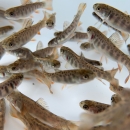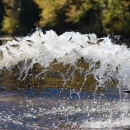Atlantic salmon are endangered. Although, they once were abundant throughout New England rivers, they are presently only found in rivers in Maine. They are anadromous, meaning they spend most of their life in the ocean, but migrate back to freshwater rivers where they were hatched to spawn (reproduce). After a long migration from the Atlantic ocean, salmon return to the rivers to spawn in the late fall months.
The Nashua National Fish Hatchery grows 100,000 Atlantic salmon for stocking Maine's Kennebec River. This population of Atlantic salmon is protected under the Endangered Species Act.
Every fall, Atlantic salmon parr (young fish less than 1 year old), that were raised at the Green Lake National Fish Hatchery are transferred to the Nashua where they are grown over the winter until they can be stocked out the following spring. Stocking occurs in the main stem and/or tributaries of the Kennebec River in Maine.
Conservation of this important species would not be possible without partnerships. We are working with the Green Lake National Fish Hatchery and the Maine Department of Marine Resources to help recover Atlantic salmon.





